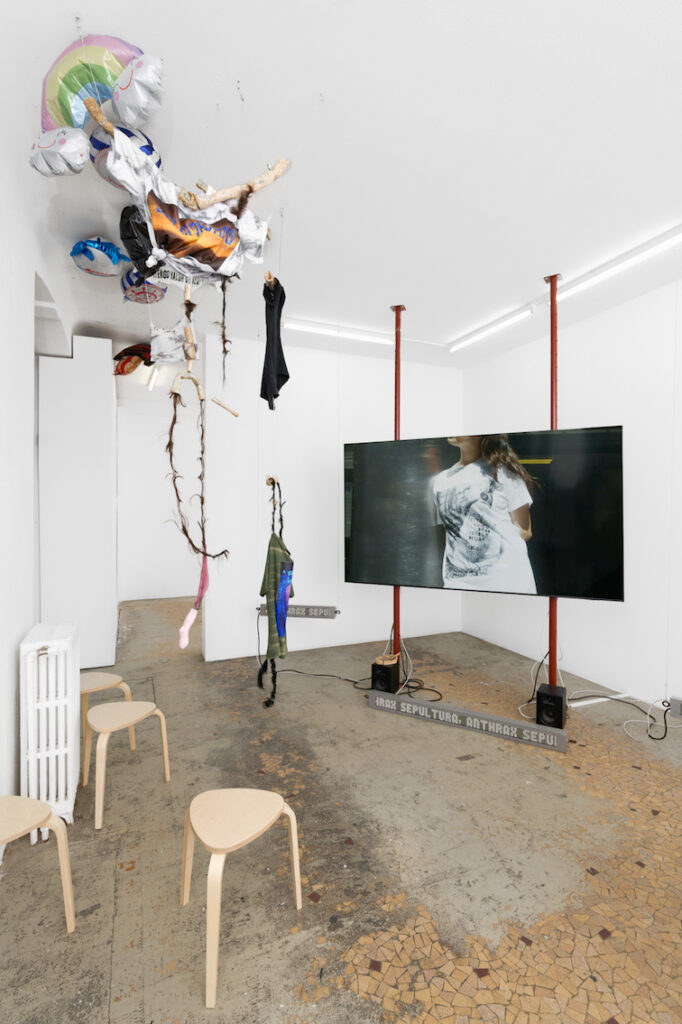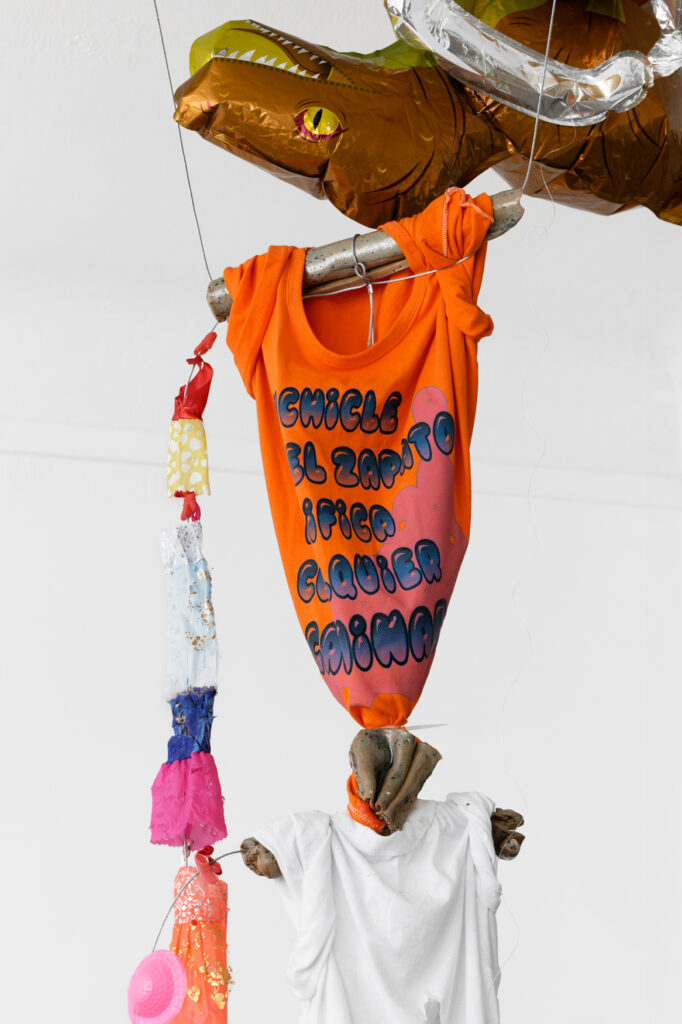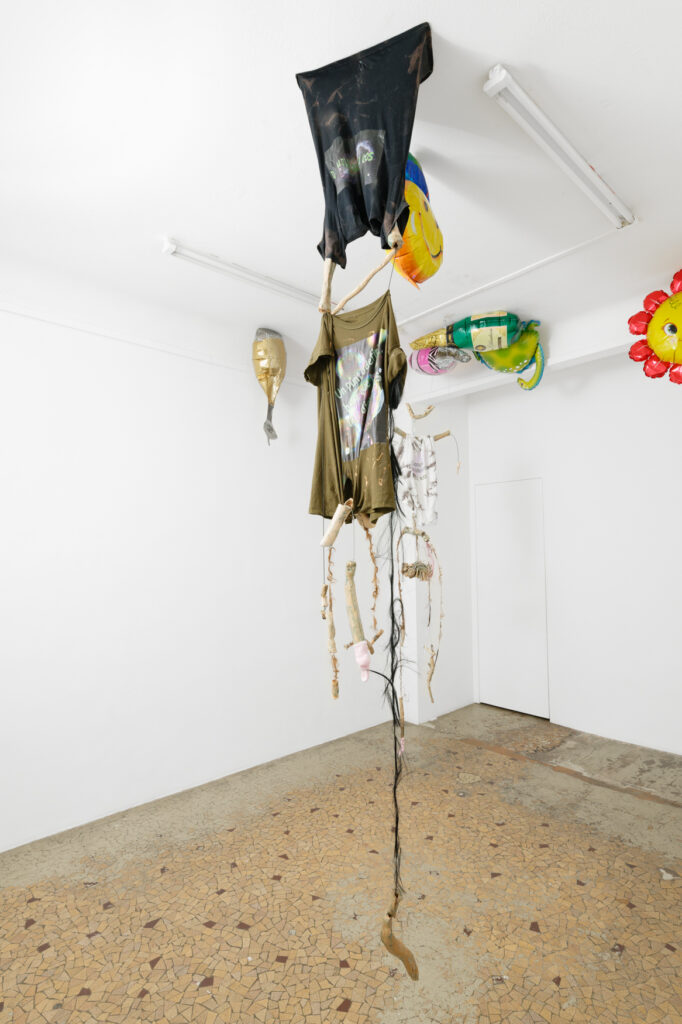On the occasion of her second exhibition at the gallery, Liv Schulman will present her new film Un círculo que se fue rodando.
The film was made on the streets of Buenos Aires, with actors, friends and aunts of the artist. It paints a psychiatric portrait of a society in permanent crisis, through a parade of T-shirts with axiomatic slogans. A number of puppets wearing the same T-shirts, suspended in the gallery space, will watch over visitors.
No one will listen to your T-shirt anymore
If Buenos Aires doesn’t exist [1], then Liv Schulman’s latest project, Un círculo que se fue rodando, makes it exist out of scale, oversized. It marks it out as a hypnotized city, or one under the effect of hypnosis, of the psychoanalyzed conversation in which its inhabitants are kept in their much-desired borderline state, but also in a supposedly communicative incoherence. In the film, Buenos Aires is a city that doesn’t listen to itself, that builds itself up under the unheard intuition of disjointed conversations, almost without continuity, that disintegrate and tend towards a free-falling discourse. But isn’t it the way it is in every city? Un círculo que se fue rodando covers not the entire surface of the city, but a tiny area, the microcentro porteño, the seat of economic ups and downs, the office life and a palpable reminder of the cultural success of Argentina’s rich industrial boom of the 1960s. The retiro, as it’s also known, is the point of arrival and departure for workers inside and out, the district where currency is exchanged all the time, where offices are transformed into apartments, where art galleries move to pay lower rents. This is Buenos Aires in love with the debt, hating it as much as it desires it, glued to the inflationary screen, the abandoned storefronts, the bureaucratic paperwork, the menus with crossed-out prices, the person strolling down a pedestrian street, who is not the same as the one confined to the sidewalk, looking ahead without worrying about the accident.
The successive crises on which this country project was built have something to do with the work, its timing and the way it was filmed. The shooting, which began some ten days before Javier Milei’s ultra-right-wing government took office, based on one of the most brutal adjustment policies in recent decades, gives the film a particular tone. Once again, popular protests have sprung up in the streets, every week Plaza del Congreso resounds with a different slogan, and the daze is such that political and emotional disorientation prevails. Speed, scene changes in sequence, interruption and incoherence mirror a confused city, Buenos Aires, but it could be any other city.
Ten years ago, a mid-career artist shouted “Let Messi pay the debt!” right downtown in Buenos Aires, and his absurd demand even failed to resonate with passers-by. Years later, a group of artists signed a letter demanding that European national heritage
heritage collection be sold to pay off the « vulture funds » (2). The artists themselves were self-deprecating, a resignation of the indebted in the face of a dollarized art market.
The schizophrenic wandering of the film’s characters and the insistent appearance of T-shirts are almost identical to Benjamin Solar Parravicini’s uncomfortable presence in Argentine culture. Although he is still little studied and exhibited, there are enough references on Google to understand his life and work, and his transition from fine art to economic prophecy. A traditional artist, he started as a figurative painter in the 1940s, but by the 1970s, he preached esotericism and frantically composed his « Prophetic Testament » – a series of premonitory drawings and texts, which were used by the media and officials of the time to justify traumatic events in Argentina’s economic and political life. The psychographies, as he called them, are vague announcements that offer guidance, and function above all as warnings and instructions. And a country fanatical about warnings is doomed to reduce itself to a state of consequence, to always be no more than an effect. Solari Parravicini announced the bombing of Amia – the Argentine Israelite Mutual Association-, the hyperinflation of 89, the crisis of 2001 and the arrival of our present president, the gray man. But also in 1972, he predicted about art: « Mechanical art is coming – intelligent and mobile – and vocal. Arte povera is coming – astral – cerebral – orthopedic -cellular- and intangible – the disartist has arrived ! ». Parravicini represents better than anyone else the crossroads between psychoanalysis, divination, tarot and economics, and that is why it is impossible not to think of him in reference to Schulman’s work.
Writing the text alone is impossible. I feel that the film is conjugated in the present continuous – which conceived in a single voice would limit to a single reading. It comes at a special time for those of us who live around here, and requires many voices to be thought through. For this reason, I am standing in front of the local cinema where the first screening of the film is taking place in Buenos Aires, for artists and people close to the art world, with the sole aim of getting the impressions of the city’s inhabitants. What do the Argentinians think of the film? It is the direct result of the sufferings due to successive, almost monthly economic crises, and the dramatic mood changes that characterize Argentinians (this is why we say liveliness and violence depict us). We know that artists invent technologies (of friendship) and strategies (of joy) to keep themselves suspended in a state of relief. But I have the impression that this film, rather than a feeling of relief, provokes a certain irritation and a withdrawal from any emotional stability.
The first person I interview is a young painter, who seems very familiar with the artist’s earlier work. She tells me that this is her masterpiece, that she reaches the pinnacle of her work by revisiting old themes and treating them differently: « I was uncomfortable, I missed parts. I didn’t understand things, but the vertigo of seeing it this way gave me a certain feeling of freshness that accompanied the film, which has a lot of lexical switching back and forth and images: it’s a crazy drift. »
Other people coming out of the movie theater tell me it’s a self-portrait, but in the hubbub I don’t quite understand why they are saying that. I turn to a curator friend, who does a rigorous analysis: « The impression I’m left with is that this is the symptom of the time that plays a leading role here, anxiety as if it were a person, a thought that doesn’t stop, folds in on itself and grows with everything it touches: it’s transmitted from a conversation to a scene, to a T-shirt, then to a sound ». She mentions the song by a well-known Argentinian rock band, which is the title of this text, and tells me that the role of T-shirts is fundamental, because they speak to people. They are the voices of the retiro. She tells me that this is Liv’s least egocentric film, it manages to open up, and it shows in the shots. She gives a formal analysis. « Form is everything, there is a cinema worship » she says.
Another artist from a neighboring country is beginning to resign himself to making a feedback, and says frankly: « I have nothing very poetic to say, but I have felt something ». He tells me that Liv’s work is based on listening to people, that she is a listening artist, and that this film perfectly depicts the feeling of walking through Buenos Aires, which had already existed in other works, but the fragment, interruption and mental health had never been so well portrayed.
Santiago Villanueva
[1] A sentence written by Marcel Duchamp when visiting Buenos Aires in 1918.
[2] Speculative investment funds specialized in buying up debts issued by distressed debtors at low prices.
____________________
Santiago Villanueva is an artist and curator. He participated in the Nuevo Museo Energía de Arte Contemporáneo (2011-2018). Between 2016 and 2017, he was curator-educator of the Buenos Aires Museum of Modern Art, and in 2021 he also curated the public and educational programs of Malba (Museo de Arte Latinoamericano de Buenos Aires). He has curated numerous exhibitions, including: Huyamos a Buenos Aires nadie podrá encontrarnos, by Roberto Jacoby (CDMX, Museo Universitario del Chopo, 2023); Todo es mucho (Buenos Aires, Universidad Torcuato Di Tella, 2022); Terapia(Buenos Aires, Museo de Arte Latinoamericano de Buenos Aires, 2021); Las relaciones mentales, by Eduardo Costa (CDMX, Museo Tamayo, 2017).
He is the author of El surrealismo rosa de hoy (2021). He has participated in several independent spaces such as Alfombra Roja, 2019 Spazio de Arte, Para vos… norma mía. He is a member of the editorial team of the journal “Segunda época”, as well as that of “Caracol” and the exhibition space “Eros”, with Nicolás Cuello.
___________________
Thanks to: Carla Barbero, Constanza Giuliani, Lulo Demarco
On the occasion of the exhibition, the cinema L’Archipel will also present the film for an exclusive screening on Tuesday November 5th 2024 at 8pm.

exhibition view Un círculo que se fue rodando by Liv Schulman
(photo Aurélien Mole)

exhibition view Un círculo que se fue rodando by Liv Schulman
(photo Aurélien Mole)

exhibition view Un círculo que se fue rodando by Liv Schulman
(photo Aurélien Mole)

exhibition view Un círculo que se fue rodando by Liv Schulman
(photo Aurélien Mole)
